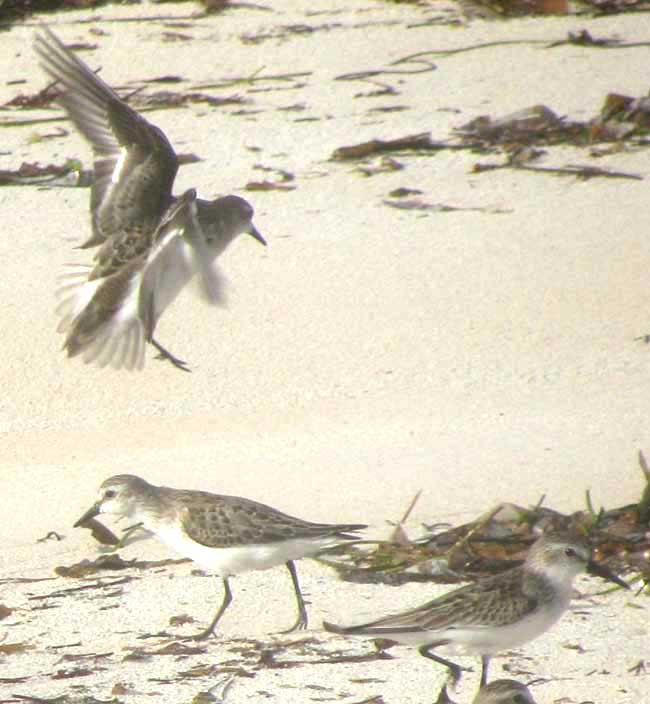Excerpts from Jim Conrad's
Naturalist Newsletter

from the September 18, 2011 Newsletter issued from Mayan Beach Garden Inn 20 kms north of Mahahual; Caribbean coastal beach and mangroves, ~N18.89°, ~W87.64°, Quintana Roo state, MÉXICO
SEMIPALMATED & WESTERN SANDPIPERS
The rest of the flock at the little wave-pool consisted of Semipalmated Sandpipers (CALIDRIS PUSILLA) and Western Sandpipers (CALIDRIS MAURI), seen above.
The flying bird in that picture, with its white wing stripes and dark rump feathers extending into the tail's center distinguish the Semipalmated and Western Sandpipers from other sandpiper species, but not from one another. In fact, it took me awhile to realize that in the picture the walking bird at the bottom left could be a different species from the one walking on the right. I thought I knew which was which, but I was so insecure about it that before naming them here I wrote to my friend David, master birder in Bermuda and absolute genius for oceanic and coastal species. He replied:
"...the left sandpiper on the ground is a classic adult Semipalmated and the right one on the ground is a classic juvenile Western."
David further explained that Westerns usually exhibit slightly downcurved bills with thickened bases, though many Semipalmated bills are nearly as long. He says that the clincher is to look for the Western's slightly larger body size, and in immature plumage the rusty reddish coverts at the shoulder. Adult Westerns usually show bolder streaking or speckling along their sides. He further points out that adults can be distinguished from immatures because adults have uneven, black blotches on wing coverts and backs. Immatures are always uniformly scalloped with buffy edges to their feathers.
Semipalmated Sandpipers, which my beat-up, 1966-issue of Robbins' Birds of North America describes as "probably the most abundant shorebird," occur here on the Yucatán Peninsula's eastern shore only during spring and fall migrations, though some overwinter on the peninsula's northern coast. The species winters from southern Mexico and the Caribbean to Chile and Argentina.
Western Sandpipers, in contrast, overwinter throughout most of Mexico, including all of coastal Yucatán. They winter from the southern US into northern South America.